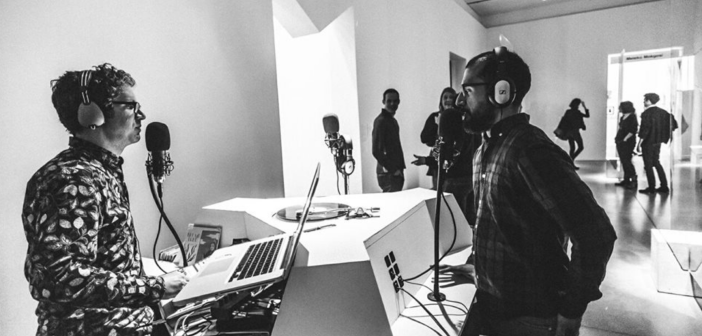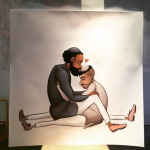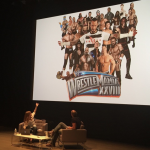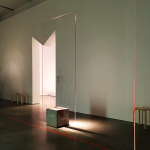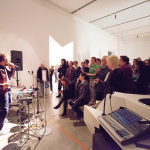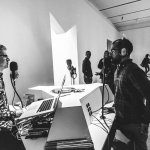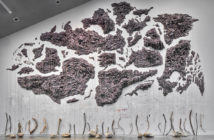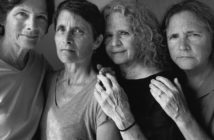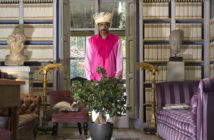Every two years the Institute of Contemporary Art Boston (ICA) selects up to four Boston-area artists as to receive the James and Audrey Foster Prize. In addition to a cash award, finalists are given the opportunity to mount a show in the ICA gallery space. Since 1999, this has been a time for the ICA to showcase local talent, ultimately contributing to a larger discourse about the role that arts institutions play in supporting Boston’s creative economy.
The 2015 Foster Prize has been awarded to Ricardo De Lima, Vela Phelan, Sandrine Schaefer, and the collective Kijidome; a four-way preferment that is unique in the history of the prize. This year’s line-up is also significant in its focus on performative and curatorial practices.
Our final interview in this series is with Ricardo De Lima.
Big Red & Shiny: How were you first approached about being considered for the Foster Prize?
Ricardo De Lima: The curators contacted me after their initial research phase. We met and they described the new, collaborative format for the 2015 Foster Prize. They requested a proposal for the show and now here we are. I was in the middle of completing my residency at Sübsamsøn and dedicated myself to crafting a proposal that would mix the certain kind of left field practices that I’m interested in with the set of visual art concerns that have been my focus more recently.
BR&S: You wear many different hats; that of DJ, curator, studio artist—how do these different creative pursuits inform one another?
RDL: Although I still need to do a lot of work to see how these processes can fold into each other in visual arts spaces, I see my current set of artistic and para-artistic projects as playing out that very question. On the collaborative/participatory spectrum, Spectacle Boston (in the lineage of Oni Gallery, Arc, Nom d’artiste, Blue Triangle, etc.) enabled certain kinds of under programmed art practices (experimental music/film, etc.) to subsist, and Picó Picante encourages an intermingling of subcultures here in Boston providing a space that celebrates "global" dance music. Some of these ideas end up in my studio practice as formal preoccupations. For example, so called "Bass culture", a set of frequency-range aesthetic priorities privileging low frequencies and big sound systems, is prompting me to create art objects using a comparable phenomenology. Bass is a physical event with an inescapable pre-verbal affect. There is a kind of violence to it. Smell behaves similarly; this is how I ended up working with caramel sugar to make sculptures.
BR&S: In choosing to include the work of other artists in your section of the Foster Prize show at the ICA, what kind of dialogue are you hoping to create with your own work? How do your curatorial practice and your studio practice interact? Where does the work of others end and your work begin?
RDL: I’m thinking of this project as an action verb, not a noun—you know, in that very naïve Richard Serra "Verb List" sort of way. Brian Friedberg, aka DJ Rizzla, not long ago articulated an ethos that still resonates with me: "amplify voices, share power, respect boundaries, decline ownership." I’ve invited a great number of smart, talented artists and this project is the tesseract of our collective efforts in the ICA gallery. The objects I’m bringing to the ICA are scaffolding for participation and collaboration. They are a kind of sculpture designed to both show art without using the walls of the institution, and also empower people to experience the art without curatorial mediation. A concrete block holds a sheet of acrylic; art goes on one side of the acrylic and a label on the other side. I have added a light in the base of the concrete that illuminates the edge of the acrylic. Originally designed by the Brazilian-Italian architect Lina Bo Bardi for the São Paulo Museum of Art (MASP) in the late 1960s, this kind of display mechanism was retired from use and abandoned in the early 90s, becoming another derelict modernism, a utopia we just didn’t want—a very politically complicated utopia mind you. I’m interested in the formal aspects of these easels—these cavaletes in Portuguese—as sculptures but also in their curatorial polemics: people wandering around them and making their own choices by navigating an open space. The ICA space is not big enough for that, but for now, it's an homage to Lina’s vision—a futurism. The Lettrist dérive, the Cageian take on the I Ching, and the spatial politics of Lefebvre’s right to the city/right to the museum run conceptually into this project.
The following artists have been invited to show work on these sculptures during the run of the Foster Prize Exhibition: Scott Patrick Wiener, who is working on an Unmanned Aerial Vehicle project using photography and installation; Adriana Warner, who has organized a show featuring a selection of art from the Visitor Assistants from the ICA; and Sweety’s, the collective run by artists Julia Pimes Mata, Bryan Rodriguez, Ximena Izquierdo Ugaz and Eduardo Restrepo Castaño, who participate in the Boston art scene by promoting and prioritizing makers of color.
Additionally, the show features a range of events, including: an experimental music collaboration with Jason Lescalleet, Caroline Park, Asha Tamirisa, and Dinnersss as part of the Non-Event concert series; screenings of experimental film as part of the Balagan film series; photography by Trevor Powers of All Visual Boston; and performative events with old and new collaborators. Jesse Kaminsky is also hosting a weekly radio show broadcast from the ICA and streamed over the Internet via WFMU. Adjunct Commuter Weekly, "the premier issue of a lifestyle magazine devoted to an important and growing demographic," edited by Dushko Petrovich for DME, will be launched at the show. David Levine, who just finished a big project for Creative Time in Central Park, did one of his "Talk Show" events with mixologist Eben Klemm, where Logan Hudson (a retired luggage handler), and Wayne Mansfield (a legend in the field of skywriting), were interviewed. Kristen Wawruck, Grants Director at New Museum, also gave a surprise slide presentation on the topic of her obsession—professional wrestling.
BR&S: Why is it important to you to "empower people to experience the art without curatorial mediation" and is such a thing even possible?
RDL: I believe most people have a highly developed aesthetic by the time they enter "high art" establishments. I believe in letting them bring their aesthetic sensibilities and agency to the table and growing their sensibilities (and mine) in the space through interaction and dialogue. Like most binaries, the curator/artist and artist/spectator dyads are problematic; this world rarely behaves like that. At the ground level, we’re all in this together—Many voices, not just one, not just mine.
- Mojuicy Bhai Log Digital print 2015 Included in the Sweety’s Installation at Another Spectacle at the ICA Foster Prize 2015
- Kristen Wawruck Slide Talk on Professional Wrestling Part of David Levine’s “Talk Show X” Presented by Ricardo De Lima at the ICA Foster Prize 2015
- Linas Concrete, acrylic, LED lights 2015
- Bomp Treb at Another Spectacle Presented by Ricardo De Lima at the ICA Foster Prize 2015
- Field Service Radio Jesse Kaminsky at Another Spectacle Presented by Ricardo De Lima at the ICA Foster Prize 2015

